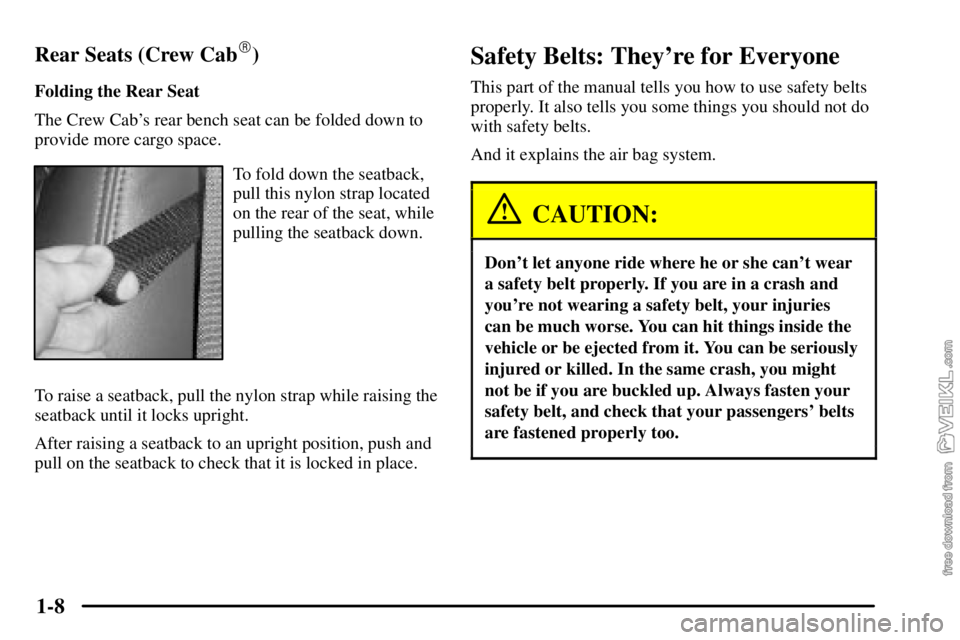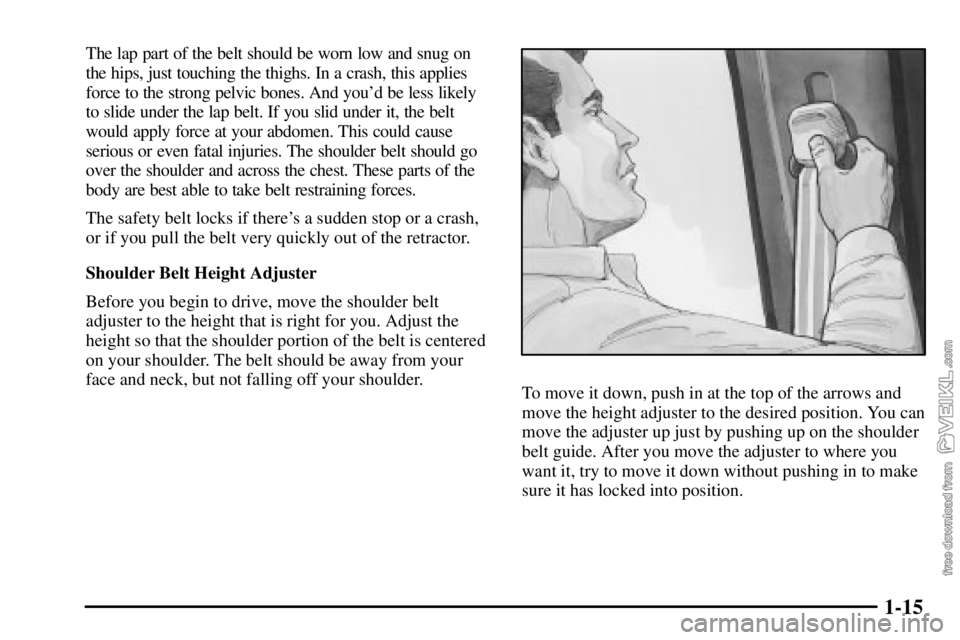Page 9 of 386
1-2
Seats and Seat Controls
This section tells you about the seats in your vehicle and
how to adjust them. It also tells you about reclining front
seatbacks.
CAUTION:
You can lose control of the vehicle if you try to
adjust the seat while the vehicle is moving. The
sudden movement could startle and confuse you,
or make you push a pedal when you don't want
to. Adjust the driver's seat only when the vehicle
is not moving.
Bucket Seats (If Equipped)
If your vehicle has bucket seats, also known as static
seats, you can adjust them forward or rearward with the
lever located at the front of the seat.
To adjust the seat, pull the lever up to release the seat
bottom. Slide the seat to where you want it and release
the lever. Then try to move the seat with your body, to
make sure the seat is locked in place.
Page 11 of 386
1-4
The seat cushion height
adjustment handle is
located underneath the
seat, in the front.
To adjust the height of the cushion, lift the cushion
height adjustment handle up and pull it forward.
You can choose between two settings.Lumbar Adjustments
The lumbar adjustment
knob is located on the
seatback, on the inboard
side of the driver's seat and
on the outboard side of the
passenger's seat.
To get more support in the lumbar area of your back,
turn the lumbar adjustment knob clockwise. To decrease
the amount of lumbar support, turn the knob
counterclockwise.
Page 12 of 386
1-5
Seatback Adjustment
The seatback adjustment
knob is located on the
inboard side of the driver's
and passenger's seat
cushions.
To tilt the seatback rearward, turn the knob
counterclockwise. Turn the knob clockwise to
tilt the seatback forward.Fore
-and-Aft Adjustment
The fore-and-aft adjustment
lever is located underneath
the seat, in the front.
To slide the seat forward or rearward, move the
lever toward the driver's door. The seat will lock in
at 1/2 inch (1.5 cm) increments.
Page 13 of 386
1-6
Chugger-Snubber Lock-Out Feature (If Equipped)
If your vehicle has this
feature, the handle is
located on the outboard
sides of the driver's and
passenger's seats.
Move the handle down to minimize any backslap
experienced while in tractor/trailer operation or while
operating a dump truck application. This feature is only
available on low
-back seats.
Reclining Front Seatbacks (If Equipped)
If your vehicle is equipped with bucket seats, you can
recline the seatbacks. The lever is located on the
outboard side of the seat cushion.
To recline the seatback, lift the lever and use your body
to move the seatback. Release the lever to lock the
seatback where you want it. Lean forward and pull up
on the lever to return the seatback to an upright position.
Page 15 of 386

1-8 Rear Seats (Crew Cab
�)
Folding the Rear Seat
The Crew Cab's rear bench seat can be folded down to
provide more cargo space.
To fold down the seatback,
pull this nylon strap located
on the rear of the seat, while
pulling the seatback down.
To raise a seatback, pull the nylon strap while raising the
seatback until it locks upright.
After raising a seatback to an upright position, push and
pull on the seatback to check that it is locked in place.
Safety Belts: They're for Everyone
This part of the manual tells you how to use safety belts
properly. It also tells you some things you should not do
with safety belts.
And it explains the air bag system.
CAUTION:
Don't let anyone ride where he or she can't wear
a safety belt properly. If you are in a crash and
you're not wearing a safety belt, your injuries
can be much worse. You can hit things inside the
vehicle or be ejected from it. You can be seriously
injured or killed. In the same crash, you might
not be if you are buckled up. Always fasten your
safety belt, and check that your passengers' belts
are fastened properly too.
Page 20 of 386

1-13
Q:If I'm a good driver, and I never drive far from
home, why should I wear safety belts?
A:You may be an excellent driver, but if you're in an
accident
-- even one that isn't your fault -- you
and your passengers can be hurt. Being a good
driver doesn't protect you from things beyond your
control, such as bad drivers.
Most accidents occur within 25 miles (40 km)
of home. And the greatest number of serious
injuries and deaths occur at speeds of less
than 40 mph (65 km/h).
Safety belts are for everyone.
How to Wear Safety Belts Properly
Adults
This part is only for people of adult size.
Be aware that there are special things to know about
safety belts and children. And there are different rules
for smaller children and babies. If a child will be riding
in your vehicle, see the part of this manual called
ªChildren.º Follow those rules for everyone's
protection.
First, you'll want to know which restraint systems your
vehicle has.
We'll start with the driver position.
Driver Position
This part describes the driver's restraint system.
Lap-Shoulder Belt
The driver has a lap-shoulder belt. Here's how to wear
it properly.
1. Close and lock the door.
2. Adjust the seat so you can sit up straight. To see
how, see ªSeatsº in the Index.
Page 21 of 386
1-14
3. Pick up the latch plate and pull the belt across you.
Don't let it get twisted. The shoulder belt may lock if
you pull the belt across you very quickly. If this
happens, let the belt go back slightly to unlock it.
Then pull the belt across you more slowly.4. Push the latch plate into the buckle until it clicks.
Pull up on the latch plate to make sure it is secure.
If the belt isn't long enough, see ªSafety Belt
Extenderº at the end of this section.
Make sure the release button on the buckle is positioned
so you would be able to unbuckle the safety belt quickly
if you ever had to.
Page 22 of 386

1-15
The lap part of the belt should be worn low and snug on
the hips, just touching the thighs. In a crash, this applies
force to the strong pelvic bones. And you'd be less likely
to slide under the lap belt. If you slid under it, the belt
would apply force at your abdomen. This could cause
serious or even fatal injuries. The shoulder belt should go
over the shoulder and across the chest. These parts of the
body are best able to take belt restraining forces.
The safety belt locks if there's a sudden stop or a crash,
or if you pull the belt very quickly out of the retractor.
Shoulder Belt Height Adjuster
Before you begin to drive, move the shoulder belt
adjuster to the height that is right for you. Adjust the
height so that the shoulder portion of the belt is centered
on your shoulder. The belt should be away from your
face and neck, but not falling off your shoulder.
To move it down, push in at the top of the arrows and
move the height adjuster to the desired position. You can
move the adjuster up just by pushing up on the shoulder
belt guide. After you move the adjuster to where you
want it, try to move it down without pushing in to make
sure it has locked into position.